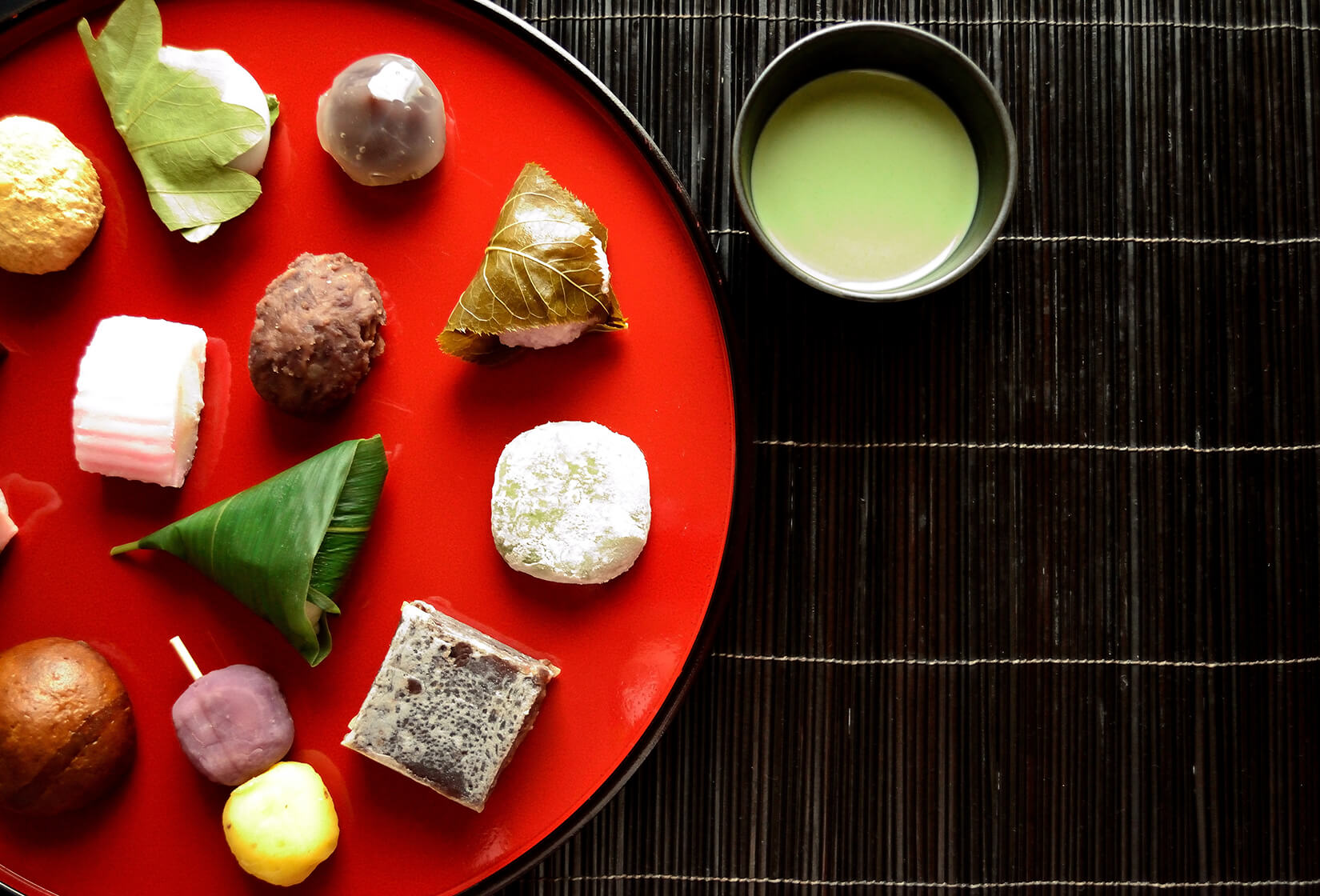A Guide to Japanese Traditional Sweets

The alluring world of Japanese traditional sweets, known as wagashi, has a wide and encompassing range of confectionaries. These sweet, bite-sized treats come in a wide variety of motifs, colors, and flavors.
As an art form that serves meaningful purposes and presents a deep-rooted tradition of Japanese culture, the level of artistry reflected in the wagashi is incomparable. The ingredients are molded into little bites of edible art – which are almost too pretty to eat.
From carefully picking each ingredient, the production method, to the seasonal variety, you will be mesmerized by how intricate the art of wagashi making can be.
Keep in mind that taste is just one aspect of wagashi; the texture, shape, and color are every bit as important. It is a testament to the creative and evolving art of Japanese cuisine. Discover the rich history and culture of Japan with every bite!
Table of contents
Wagashi: Little Bites of Japan’s Traditional Sweets

The term wagashi is a combination of two words: “wa”(和)meaning Japanese, and “kashi”(菓子)meaning candy. The variety of Japanese sweets are overwhelmingly numerous. Collectively, they represent a celebration of global history, works of art that demands all five senses, and a reflection of the season and locale.
Wagashi encompasses all Japanese desserts, from the traditional tea ceremony delicacies to everyday common desserts. Famous variations include dango (skewered mochi balls), dorayaki (mini pancakes sandwiched with a sweet filling), and sakura mochi (cherry blossom pink mochi with red bean paste inside).
Japanese traditional sweets are known for their minimal use of oil, spices, and dairy products. Its main ingredients are grains from wheat or rice, starch from red beans or soybeans, and sugar. While it comes in all shapes and sizes, most wagashi are notably small enough to be eaten within two or three bites.
Overseas Influences – Early Days of Wagashi

Today’s wagashi is the culmination of many overseas influences. Between the years 630 and 894, Japanese envoys to China brought back exotic sweets made of soybeans, wheat, rice, and azuki beans. From this, a deep-fried mochi made from rice, wheat, and soybeans called kara-kudamono was born and is said to be the origins of early wagashi.
In the 16th century, Spanish and Portuguese merchants introduced a new culture and cuisine to traditional Japan. This was when the country adopted the introduction of refined sugar and the use of eggs and flour to make confections such as castella (Portuguese sponge cake) and kompeito (crystal sugar candy).
However, it was during the Edo period (1603-1867) when Japanese sweets flourished the most. Many famous wagashi varieties eaten today are believed to have emerged during this time.
Wagashi and Japanese Tea Ceremony

Another interesting thing to know about wagashi is the part it plays in the traditional Japanese tea ceremony. These sweets are known to pair well with green tea. It has been typically enjoyed as a combination, which is why these traditional sweets are deeply rooted in the culture of Japan.
Wagashi adds sweetness to the palate and complements the bitter taste of matcha, Japan’s green tea. Japanese people regard the bittersweet taste as a heavenly combination.
It is important to note how the sweet treats are usually consumed first before the tea is served, and never together. This is done so guests can focus on the bitter, deep taste of matcha while the sweetness of the treats still lingers in the mouth.
Famous Wagashi Varieties

There are three main categories of Japanese wagashi: namagashi (fresh confections), han namagashi (half-dry confections) and higashi (dry confections).
The sweetness of these bite-sized treats is controlled to make the most of the original flavor of the ingredients, such as red azuki beans or the white kidney beans. You can find many types of wagashi, and here are some of the crowd favorites:
-
Amanatto
– Azuki beans cooked in a sugar syrup
-
Chimaki
– Sweet rice dumpling wrapped in bamboo leaves
-
Daifuku
– Mochi wrapped in a small round of sweet bean paste
-
Kasutera (Castella)
– Sponge cake made of wheat flour, sugar, and eggs
-
Kompeito
– Little sugar balls made from syrup and cornstarch
-
Kushi-dango
– Rice flour balls coated with soy sauce and sugar sauce
-
Manju
– Pastry cakes of steamed dough, filled with red bean paste
-
Monaka
– Made of a wafer shell filled with sweet bean paste
-
Namagashi
– Made of rice flour and sweet bean paste filling
-
Nerikiri
– Made from sticky rice flour, sugar, and white bean, molded into shapes
-
Ohagi
– Sweet rice balls made with glutinous rice
-
Taiyaki
– Fish-shaped pancake filled with red bean paste
-
Yokan
– Sweet, firm, jelly-like snack made of sugar and kanten agar
Seasonal Wagashi

Since the Japanese are known to take immense pride over the 4 distinct seasons, this custom is also observed in the art of wagashi. Motifs such as maple leaf shapes for fall and plum blossom designs in the spring may be common. In essence, wagashi is not just a dessert but an art.
From the design, motifs, and ingredients, seasonal treats are usually eaten on special events. It may also be served as an offering to the ancestors.
Japanese New Years:
-
Kagami mochi(鏡餅)
– Two round mochi atop each other with an attached leaf on top
-
Hanabira-mochi(葩餅)
– White mochi wrapped around a pink mochi with a center of white anko and a candied gobo root
Spring:
-
Sakura mochi(桜餅)
– Sweet pink-colored mochi with a red bean paste center, wrapped in a pickled cherry blossom leaf
-
Hanami-dango(花見団子)
– 3 dango balls colored pink, white, and green, skewered on a stick
Summer:
-
Kashiwa-mochi(柏餅)
– Rice cake with red bean paste filling, wrapped in oak leaves
-
Kuzu-kiri(葛切り)
– Clear cake of boiled kuzuko cut into noodle-like strips and eaten with kuromitsu
Autumn:
-
Tsukimi-dango(月見団子)
– Rice cake balls offered for the moon festival
-
Ohagi(お萩)
– Rice cake covered with bean jam
Winter:
-
Chitose-ame(千歳飴)
– Long, thin, red and white candy given to children on Shichi-Go-San (A rite of passage festival for children)
-
Inoko-mochi(亥の子餅)
– Mochi shaped into a boar, to be eaten on the day of the boar (10th month in the lunar calendar)
Wagashi and the five senses

Appreciating wagashi makes use of the five senses.
For instance, the sound of the wagashi name must conjure up beautiful imagery. Its mere mention must evoke seasons, legends, or historical episodes. Additionally, the texture must feel good to slice or cut, and equally so with its mouthfeel. Each wagashi piece is known to have a gustative texture of its own. The subtle fragrance of each treat is also observed so it does not alter the delicate smell of green tea in a tea ceremony session.
As wagashi are confections, it must be a feast for both the eyes and the mouth. The flavor must delight the palate, the same way the beauty of the colors and shapes satisfy the sight. Their designs often represent the beauty of flowers, dream landscapes, or the seasonal transience of nature.
The changing of the season is whimsically colorful and beautiful; wagashi hopes to express these evocative images of nature that appeal to the five senses.
Conclusion
A lot of Japanese culture and cuisine draw on the principles of aesthetic beauty and the passing of the season, wagashi are made bearing the same principles in mind. Taste is just one aspect of wagashi; the texture, shape, and color are every bit as important. It bears testament to the creative and evolving art of Japanese cuisine.
Wagashi shops in Japan sell seasonally varied treats, such as in design and flavor, to express the changing of the season. You may be in for some limited time treats depending on the season of your stay in the country.
The list of wagashi items seem to be endless. With every bite, discover both deliciousness and the rich history and culture of Japan!
Motto Japan, the community platform to support foreigners with the foundation for life in Japan, including Japanese study, job opportunities, and housing service. Motto Japan Media will provide a wide variety of information for Japanese fans all over the world, to create a cross-cultural environment and enrich the life of foreign residents in Japan!













Leave a Reply